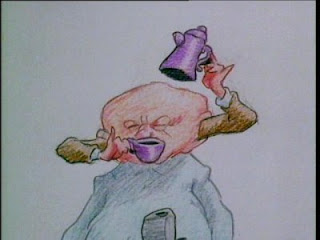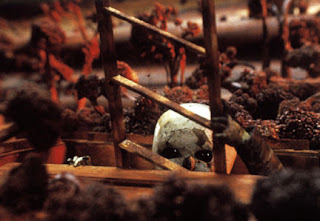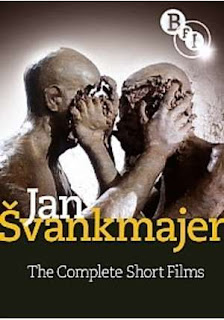
7 Apr 2010
4 Apr 2010
30 Mar 2010
Animatic for The Lascivious Umbrella
The Animatic is constructed from Storyboard panels, but there will be one more from keyframes, just to get the better and more exact idea of the timing.
Understanding the Mechanics of a Walkcycle
Simply enough, half of the period of the walk cycle ( the interval between one foot being raised up from the ground till it's again touching the ground) is constructed of main 5 poses:
By repeating those poses and adding characteristics, weight we get different walk types. The difference should be evident in every walk cycle.
Also, please consider following my blog, full of creative visuals, CGI and reflective writings on film, animation and art theory.Cheers!
29 Mar 2010
Animation theatre 5: Rene Laloux and Bill Plymton

Fantastic Planet - Rene Laloux
It is something different for today's film viewer to see. The pace of animation, the concept design and the performance doesn't instantly appear appealing. The animation is choppy and there are constantly completely still parts not changed over time ( for example hand raising the Om up in the air) . This seemingly gives stylization to animation - brings surrealism.
In The Cell ( 2000, Dir. Tarsem Singh) there was a scene when Catherine was about to sleep watching TV . That TV was showing the scene From Fantastic Planet - the boy when he was first introduced with the coller thus trapping him.
THE TUNE - Bill Plymton
Bill Plymton has a strong opinion about character design. He marks, that the more bland and plain sort of extremely recognizable the character looks, the bigger contrast there is when things turn crazy and to his mind this is the key to successful animation.
And it is evident in The Tune. We are introduced with the normal and the banal and this is the huge contrast to the surrealistic morphing, and the overall fantastic actions that are taking place .


The animation instantly could seem making no sense, but actually it could be interpreted the images have a metaphorical meaning there. For example the scene where apparently a man is about to eat a hamburger suddenly gets eaten by it instead...So who's eating who finally?... That could be the interpreted meaning of that. But the animation is full of it.
And It just has to be mentioned. The unique use of voice recording - so stylized, gives such an interesting effect to animation.
Having mentioned only few points, the overall product is a marvelous peace of great imagination and skills.
Up - (2009)



It is a story about an old man who after loosing something of great importance finally moves forward and meets new adventures.
It is really an example of great animation. The world created feels so natural and believable. Probably most of that comes from a believable performance. There constantly were evidence of attention to slightest details such as the move of dogs tongue or eyelids shaking from nerves, I'd guess those details aren't serving the animator, because it makes the audience forget they are seeing animation - you then find yourself deeply connected with the flow of the story .
A keen observer probably would notice the active camera movements. For example in the scene where the house was caught by a storm and it was necessary to create the chaotic feeling. Cameras were jumping from the place where dishes felt down to the shocked faces of Russell and Carl. But it was contributing to the story, not distracting or irritating (at least to me) - probably because the creators didn't over used it.
It might be said, the movie is so successful (the rating in IMDB is 8.4) because of its characters .
even those who appear for only few moments are so individual and well constructed. And seemingly the creators aren't going for the most typical characters with the predictable performances, body languages and reactions and its true throughout the film even if it's a main character or the one for brief moment.
And to make it all appealing here comes the design. Gorgeous.
26 Mar 2010
Storyboard for Lascivious Umbrella
24 Mar 2010
Steamboat Willy (1928)
The huge success of the Jazz singer in early 1928 had opened prospect of talking pictures.
Steamboat Willy was the first cartoon created that had synchronized sound in the same years of 1928.
When the animation with the synchronized sound on top was first played for the audience, Walt Disney recalls: "The effect on our little audience was nothing less an electric... It was terrible, but it was wonderful! And it was something new!"
At that time this idea that moving fictional drawn characters could mimic life, that is, talk, make sounds at that time was understood as something magical and thrilling, The sound used was as unreal as the action all of which is evident in Steamboat Willy.
Watching the Animation one perhaps wouldn’t guess it was the first attempt in synchronizing the sound, since animations that followed took the same approach. On the other hand You’d become aware they are a bit jerky and ruff around the edges.
Nevertheless the sound definitely contributes to the grate impact of animation
The Script for the Lascivious Umbrella

We see a wardrobe door.
Hand opens it
Puts the Umbrella in
There we see:
Umbrella after a slight pause notices the raincoat
He… calls for attention (by slightly widening his canopy few times first slightly and slow than a bit faster)
Waits for her response looking at her ( few moments of only slightest moves)
She turns to him and slightly ‘jogges’ showing an interest
He is excited and doesn’t wait to begin the performance
He JUMPS! in the air and POPS! Wide opening the canopy
Gets down bumping the flor a bit and leanes slightly back just to...
Start the shaking of the canopy in the way a peacock shakes his feathers.
Dances around her slightly stopping at a different points ( like just to fix the moment)
(finishes the ‘circle’ around her)
He again leans down to the ground abit (but more than the last time) and slightly closes his canopy
Jumps in the air! ( this time higher and more enthusiastic as well as drawing a curve in the air ( he is next to her and she is slightly turned to him) Popping open in to a hart-shaped canopy
And steadily,like a lightest balloon goes down beating like a hart ( such impression is created by the convulsing outlines or the continuously ‘beating’ colour)
Just before reaching the ground (one fourth of a fall) he comes back to it’s normal canopy-closed shape
And lands in to a split
Makes a slight move towards her to see the reaction/answer.
She’s amazed, she ‘jogges’ now stronger and claps her leaves
(MCU) they are getting closer to each other…
(CU) and closer…
Suddenly!
Doors open wide,
Quickly the hand reaches for ...(everything's seen from the hand angle)
(Hands POV) grabs the puzzled raincoat.
we see a shocked umbrella!(while hearing slapping door sound)
And (‘AAAwwww’) umbrella’s left disappointed… :/
xxx
Life Drawing : Conecting Body Volumes With the Negative Space
Also, please consider following my blog, full of creative visuals, CGI and reflective writings on film, animation and art theory. Cheers!
Felix the Cat (1919)


Felix the cat was a stylized black and white cartoon first created in 1919 by Otto Messmer in Faline Follies . This was highly influential to future’s cartoons, for example in 1920 a coloured cartoon The Debut of Thomas the Cat was produced. Also at that time it was world’s most famous cartoon till Mickey’s Mouse appearance.
22 Mar 2010
A Whole Group of Bouncing Balls

Friday we had our second animation workshop, this time focusing on spacing and timing in the animation. With out good timing and spacing you find yourself creating only movement.
Also it is crucial to pay attention to forces such as gravity or frictional forces.
Subsequently, to put it in practise we were asked to animate three different balls ; rubber, bowling and ping-pong balls.
Meg Bisineer strongly recommended first plan the the animation including considerations about the difference of materials and how it can be conveyed in timing and spacing .
This is .. my quit scary looking plans of animation, but they were helpfull. I spent half of the time planing the movement and the other half just redrawing and correcting. Still.. I wouldn;t guess the tipes of ball bouncing..
Jan Svankmajer - Darkness/Light/Darkness
We see a pair of hands being confused and yet searching for something that is important to them (as we go along we understand they are looking for missing body parts and trying to make sense of them experimenting as they go along).
Interesting how hands are in control. Even if the head is being properly constructed – it has brains, eyes, tongue etc. it still isn’t in charge, and only passively watches what hands are doing or suffers if they are being incautious ( bump the head with the doors).
I’m not quite sure what’s the idea or the meaning of this animation, I sure want to ask. If anyone has a suggestion, interpretation or answer don’t hesitate to write it J
But this is once again a very creative work from Jan Svankmajer, something really rare to see.
Animation Theatre 4: Getting back to the Uncanny Valley


Today we saw Jan Svankmajer’s dimensions of dialogue, Brother Quay’s Street of Crocodiles and The Comb also Jiri Barta’s The Club of the laid of.
All of the works has the specific uncanny feel. That probably comes from the familiar being put in an unexpected way.
An example of that would be from Jan Svankmajer’s Dimensions of Dialogue. Clay sculptures of human figures and its performance –the animation were convincing enough to be perceived as real human (in particular as lovers). The beginning of animation presents a normal situation, a man and a woman figures start feeling emotions over each other. Than rapidly the animation goes to extremes – they start making love and literally grow into each other. A very interesting moment was when suddenly them coming back at ease we see a bit of shapeless clay between them – apparently it came from their body material, but not one of them wants it back. I’d interpret it , they have lost something , that tiny bit of them selves that’s very important. Subsequently wee see a change in both of the figures – rather than being sensitive and loving as in the beginning they literally destroy each other.
I noticed Svankmajer first depicts the normal (the meet is sliced) then presents an odd situation (meet starts dancing) and the audience starts feel for the characters and believes in the world created when suddenly (now) something unexpected happens or rather characters get back to their original matters (the sliced meet is being baked, human figures become a mass of clay).
There is just so much more to talk about, to give only few examples – the constant appearance of sex and genital symbols, the rich textures, the stylization, and the construction of atmosphere or the huge difference of the Easter European animation



